#my step-grandparents had a ramp built at their house for them
Text
Hey so I’ve mentioned this a lot of times on my main blog, but I wanted to put this out over here since it is Hallow’s Eve. I always give out little tchotchkes on Halloween along with candy. This year, I’ve completely switched over to 100% doohickeys and doodads— think mechanical pencils, shaped erasers, little notebooks, squishes, vampire teeth and spiders rings and all. It started years ago in college when I signed up for a dorm Halloween event where kids from an area that was too dangerous to really trick or treat through got bussed in to trick or treat at our dorm. I bought some candy and dollar store Halloween themed stuff with what i had. And you know what the kids went ape shit over?
Motherfucking. Mechanical. PENCILS!!
These kids could not get enough of them. They literally went “PENCILS??!” I had never seen kids get so hyped up for pencils lmao. They were the first things to go. Candy is fleeting; the little pencils you can bring to school to flex are eternal, until you inevitably lose one of the refill parts and then they aren’t but listen, in that one moment they are infinite. And its nice thinking that maybe some kids who don’t always have access to school supplies not only get them, but get them in fun shapes and designs.
Anyway. I recommend people to give out fun stuff like this not just because kids seem to genuinely enjoy them, but also because there’s this thing called the Teal Pumpkin Project here in America. You can put out a teal pumpkin to show that you are giving away non-candy items and sign your address up so parents of children with allergies know that there are houses their kids can safely and happily trick or treat at! It’s a win-win! Plus, if you accidentally bought too much, it’s not like candy— just pack it away, pencils and fidget spinners will be good next year, too! :)
#its such an easy and fun thing to do#and it helps make Halloween accessible for some kids who might otherwise not be able to participate#i always think about stuff like that#my step-grandparents had a ramp built at their house for them#but one great unintended side effect is that they always got a lot of children in wheelchairs to their house on Halloween#who were so so excited they could go up to the door and ring the bell for once :’)#so like i always try to think of ways to maybe include people who might have trouble otherwise when i can!#and this is such a little but easy to do change#i like to source my stuff from the dollar store targets dollar area and amazon#i bet party supply stores (think party favor bag stuff) would work great too#so. if you have time tomorrow maybe run on over to the dollar store during your lunch hour#grab some random little things. kids will go crazy. maybe you’ll brighten someone’s day
240 notes
·
View notes
Text
Meeting the family.

Syn’Da invites her boyfriend’s family to meet her parents.

The lake house on Naboo had belonged to Syn’Da’s great-Grandparents, their wedding portrait hung in the main hall, watching everyone who entered.
It was built in the old style. It had belonged to her Grandfather’s side of the family for centuries. It seemed the Riss family were as old as Naboo itself.
Syn’Da didn’t grow up here, she grew up in a modest cottage on the planet of Lira San, Where her Father, Alexander helped the Lasat people rebuild after the Empire almost wiped them out.
But home was wherever her Fathers were, it didn’t matter what star cluster they were in.
Syn’Da stood on the back porch, watching the lake, She had invited her boyfriend, Ben too come meet her family and she was nervous.
She shouldn’t be, Her Father, Lokki and Ben’s Mother, Leia have known each other since childhood, so there would be no clashing there.
But would Ben’s Mother like her?
Leia Organa was a Senator and a war hero, Little girls all across the galaxy looked up to her.
Then there was Rogue, Ben’s step-Mother, who was a galaxy famous guitar player for the band Cosmic Heartbreakers.
That was a lot to live up too.
“They’re here!” Alexsander’s voice carried through the house.
Syn’Da took a deep breath.
X
“It will be nice to catch up with Leia again.” Lokki commented to Alexsander as they stood on the landing platform in front of the house.
“You spoke to her on behalf of the Lasat only last month.” Alexsander replies with a smile “Hardly a lifetime ago.”
“We haven’t had time to talk, talk..” Lokki smoothes down a wrinkle in the fabric of his dark green cloak “Small galaxy that our daughter would fall in love with her son.”
“Is your Mother joining us?”
“Later, she seems even busier these days than she was during the war..”
Alexsander laughs “She’s allergic to relaxing.”
As Syn’Da joined them, the door of the ship in front of them opened its loading ramp, first came the gold protocol droid that frankly, Lokki was amazed hadn’t been scrapped for parts.
Then came Leia, dressed in her trademark white with her wife, Rogue at her side, who was wearing a black garment that was somewhere between a dress and a bodysuit. It made her look like a ghost.
“Princess!” Lokki walks towards Leia and embraces her
“Lokki.” She hugs him back “It's been too long since we met socially.”
“It has.”
Lokki broke the hug and held out a hand to Rogue, who he knew wasn’t a hugger.
“Nice house here.” Rogue shakes his hand, her nails scratch his palm “Its old.”
“The ancestral home of the Riss clan.”
Rogue smirks “Hardly a clan.”
“Of course, I forgot, you Mando’s use the word clan differently.”
Rogue chuckles “Not much of a Mando these days, more just…” she gestures vaguely to herself “Just Rogue.”
Lokki nods “That's good enough for me.”
Rogue walks away, off to greet Alexsander and Syn’Da.
Lokki focus’s on the other figure who had quietly exited the ship.
He wore simple black, nothing flashy, and had his black hair brushed out of his face.
“Ben.” Lokki greets.
They had met before, in passing when Ben was a child but this was a new sort of meeting, This boy was dating his eldest daughter.
“Lord Riss.”
Lokki laughs and steps forward
“Lokki, Please.”
Ben nods
“Hows your Father?” Lokki smiles “He owes me a hundred credits but doesn’t return my calls.”
Ben laughs “He’s well…I’ll uhh..I’ll remind him to repay you.”
“Good, good.” Lokki clasps Ben on the shoulder “I think you’ll be a perfect addition to Syn’Da’s life.”

#OC: Syn'Da Riss#OC: Lokki Riss#OC: Rogue Aleeka#alexsandr kallus x oc#ONE DAY I'll spell his name right I promise#leia organa x OFC#leia organa#Ben Solo
1 note
·
View note
Text
Sheyenne River Academy Campus, North Dakota 1

Those of you who know me, know that ever since I could talk I would point to places and ask, “Who lives there?” As I got older I zeroed in on abandoned houses and then abandoned places in general. There’s a pull about them. They call to me. But no matter how many abandoned places I explored, no matter how cool or historical, there was always my white whale in the back of my mind. Sheyenne River Academy. I asked dad for years and years to take me there. I could photograph and explore all the abandoned places in the world, but if I didn’t see SRA, what was the point?
You see, SRA is where my parents met. Several of my grandparents went there, too. In fact, most of my family members attended SRA before it closed in the late 1970s. There is such history about this place. And yet I only saw it briefly on an old video or two. One taken in the 50s, one in the 90s after it had been abandoned.
My parents were the second-to-last graduating class of SRA: 1976. After the class of 1977, everyone went on to the place where I attended high school: DAA. SRA was near Harvey out in the country. DAA was near Bismarck out in the country. SRA was a classic brick and mortar campus with many buildings. DAA was all in one - a strange building, shaped like a spider. Some say that the goodness left the school after SRA closed, and with DAA it was never the same. All of this has culminated in creating a place that I have been obsessed with visiting, no matter the state it is in.
Especially since my mom passed away in 2012, I wanted to visit. I wanted to see where she “endured” high school, where she and my dad met. And although the tour wasn’t as thorough as I would have liked (SRA continues to be a bit of my “white whale”) I had a blast exploring this place and hearing dad’s stories.
I’ll do my best to recreate our time there for you. I’m not a great photographer, not a perfect writer, and don’t have a super clear memory about all I learned that day. But here is my level best to share Sheyenne River Academy with you all.
--
Would you like a full, immersive experience of our visit to SRA? Let the music take you back while you scroll along!
Click here for the secular playlist for 1970s SRA.
And click here for the special SDA playlist!
Let’s go!
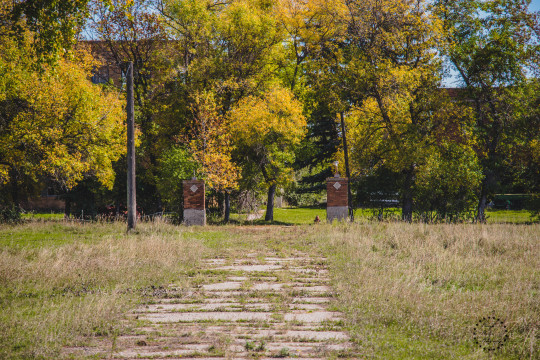
When we first arrived at SRA, it was shrouded by trees. Taunting me. I was close. So close. But not there yet. Dad ran around (literally) trying to find the person who owns it now to get permission for us to walk around. After quite awhile he got it. We were in.
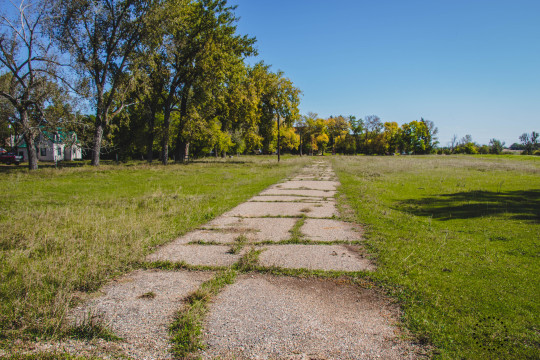
While dad ran around, I prowled the perimeter taking photos from a distance.

I couldn’t miss the overgrown driveway, nor the brick columns. So fancy. So formal. So overgrown and mysterious.

We couldn’t have picked a more beautiful day. A perfect fall day. However the light was very harsh, which didn’t help my photos.

Here’s a photo from the old 1976 SRA yearbook taken around this same area. Dad thinks these two guys did a week of prayer that school year.

When we first arrived, I noticed there was a sign . . .

. . .and a curious cow.

There were also many houses surrounding the campus. If you didn't know what this place was, you’d probably be confused. The houses you see were where the teachers and staff lived.
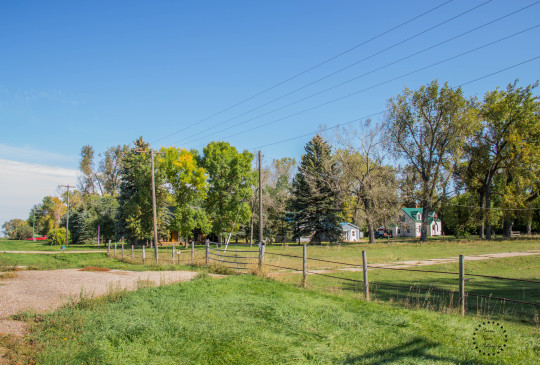
The sign once said Sheyenne River, but now had a pretty painting with the words, “Villa Bonacci Peaceful Valley” on it. I did hear that after the school closed, someone tried to reopen it as a health retreat of some sort.

Finally it was time! We parked at a house that used to belong to the principal and walked down the road to SRA.
Sheyenne River Academy first opened in approximately 1904 (so says my dad). Being open over 70 years doesn’t feel long enough for this beautiful old campus.

I couldn’t wait to hear dad’s memories - he was the best tour guide, as I knew he would be. Dad is very unsentimental on the whole, so instead of being upset at the state of his alma mater, he was simply curious and recalled all sorts of stories and facts about the place.

We first arrived at the boys’ dorm. The building to the left was the Ad Building, and we will get to that later.
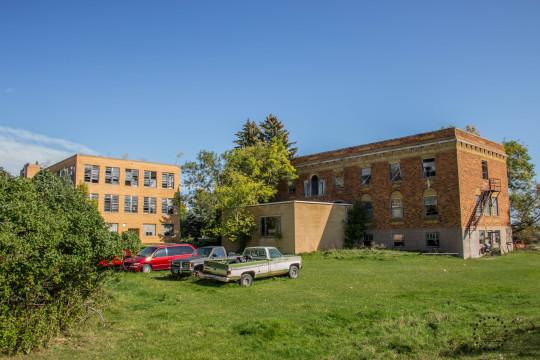
Immediately dad pointed out the window to his old dorm room from his senior year - it has an auger sticking out of it.
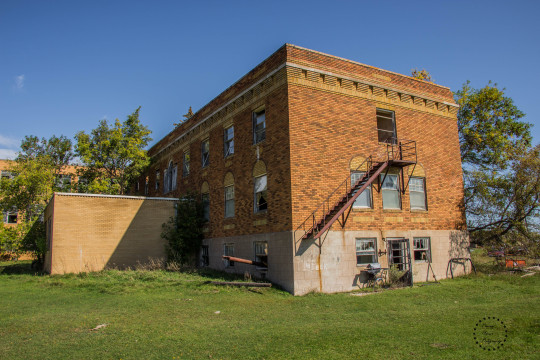
Since his room was right at the end on the ground floor - could we see it?
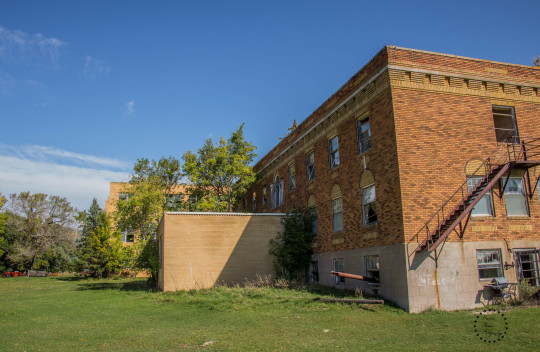
Yes, we could!

Here is is! Dad’s dorm room. He said it was old even when he lived there - the pipe was still sticking out of the ceiling then, too. Although it was considerably less...cluttered. However, one of dad's friends apparently says it looks much neater now than when he lived there. Ha!

Look past the clutter and picture it has it would have been. And enjoy this story dad shared with me that deeply impressed me.
I asked dad if they were allowed to have music in their dorm rooms (that policy was fairly lax by the time I got to DAA and dad of course had me set up with a great stereo my years in the dorm) because I figured if anyone would have had a stereo in their dorm room it would have been my dad. He said radios were in fact not allowed until his senior year. So they rigged up a system. Because when you live at your school, you have to find a way around the arbitrary rules! (Believe me, I know!)
Dad says that many guys, himself included (of course - I’m guessing he was a pioneer of this system*), had their rooms “wired”. I was picturing a Ferris Beuller situation as he said this and, it turns out, I wasn’t far off.
These guys used wires and switches to set up their radio so that if someone (the dean) came in while you had your music on, it would shut off when the door opened. Dad also had a switch wired in the dresser drawer so you could subtly turn the music on/off as well.
I have to say I’m proud to be related to one of the people who did this. So innovative! It made my dorm shenanigans look pathetic in comparison!
* Update from dad: Clandestine sound wiring (with door switches and drawer switch cutoffs) was around for years before I got to SRA, so definitely not my invention. I just followed how the pioneers did it!

And here is the hallway. More junk.

The dorm room across from my dad’s room - he said to belonged to his lifelong friend, Lynn.
Lynn, your room needs cleaning. It’s full of old foam insulation.

Back out we went. Lots more to see!

Here is the back of the boy’s dorm. The original structure was built sometime in the late 1920s.

You can see the added-on shower wing. It was built in the early 1960s.
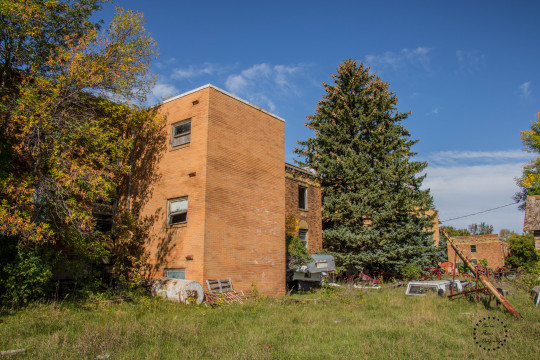
Here you can tell the difference in brick - the original structure vs the add on.
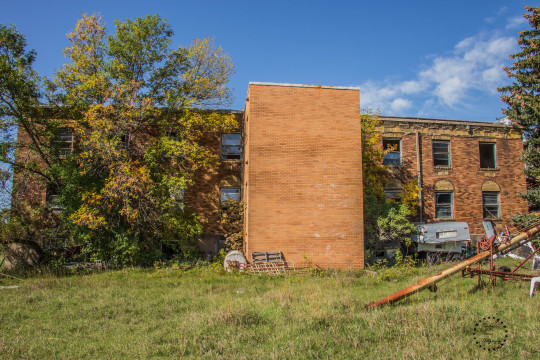
The original portion is quite old - my grandparents would have been familiar with it.

Below: a page from the 1976 SRA yearbook, a bunch of cool guys rock out by the boys’ dorm in the spot pictured above.
Dad noted that this picture had the negative reversed when it was put in the annual.
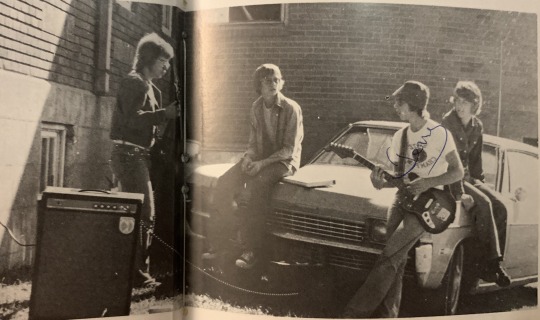
Cars littered the property. The owner uses it as a wrecking yard now. Not for the first time did I find myself thinking, “What a waste.”

This building looked quite old, so it caught my eye.

Dad said it was just a maintenance/storage building.

Looking back at the boys’ dorm.

Here we have the cafeteria and gym! Look closely - someone ran dirt (which eventually grew grass) up the steps so it would be a ramp instead of stairs.

We headed around the side.

This may be storage now, but back in the day it was the cafeteria!
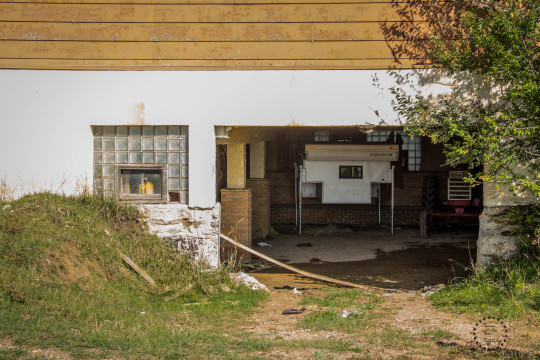
I was shocked. At DAA, where I attended, the cafe was the most beautiful part of the school, overlooking the Missouri River valley. One of my favorite things was seeing the mist rise off the river on a chilly fall morning. SRA’s cafeteria is so...well it’s a basement! This is where the students would eat chili and cinnamon rolls on Friday evenings (a tradition carried on at DAA). Where people agonized over who to sit beside. I just had trouble picturing it, even though I was right there.
I remember mom telling me that at the entrance to the cafe there was a ledge where a boy would sit and when she and her friends would pass through he would swing down and scare them.

A photo from the 1976 SRA yearbook below, taken in the same spot.

Below: a photo from the 1975 SRA yearbook.
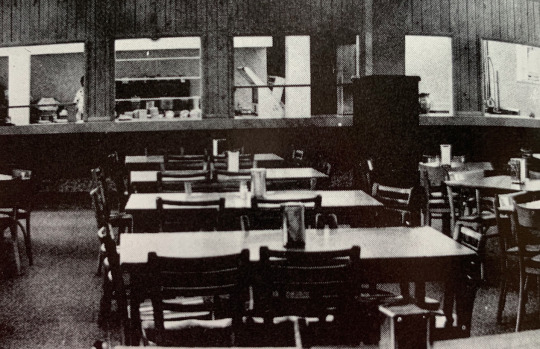
Dad pointed out that to the back on the right was where they served the food. I wanted to go back but dad said no.
Fun facts: dad’s favorite breakfast was Friday morning coffee cake. My mom got the recipe and made it for us more than once when we were growing up. I still have it somewhere. One of dad’s favorite meals was Friday evening, which I mentioned above, chili or fruit soup and cinnamon rolls. I didn’t mind that particular meal when I attended DAA, but got sick of it after awhile. Dad’s only real negative comment about the cafe (when I asked him) was that sometimes, as a growing teenage boy, it felt like you didn't get enough food. However, on the whole it was good, he said.
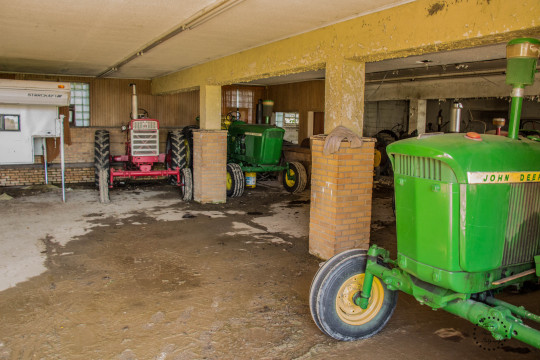
Below: a photo taken in roughly the same location, from the SRA 1976 yearbook. That’s my mom with the long blonde hair, somewhat facing the camera on the left.

I heard from my mom that the food in this cafe was good, and she even had some hand written recipes she got from the cooks here! I believe one of them is for “melting moments” cookies. I have that recipe card, and made those cookies with her as a child. SRA students - what food did you enjoy eating here? And what made you cringe?
I looked down at the muddy floor. How many bell bottom jeans brushed across that floor in the last days of SRA?

Below: photos from the 1976 SRA yearbook - a banquet!

This banquet - “Nights in Satin” according to the yearbook. Most of our banquets at DAA were just as cheesy.
Note from dad: It was "Nights in White Satin", a popular song of the day by the Moody Blues. I think they made the student banquet organizers change it to "Knights in White Satin" to remove any suggestive/amorous connotations. Of course, this spelling made no sense, but I think Kathy Diede, class artist, drew up a picture of a knight along with the chosen theme to hang on the cafeteria wall to decorate for the event.
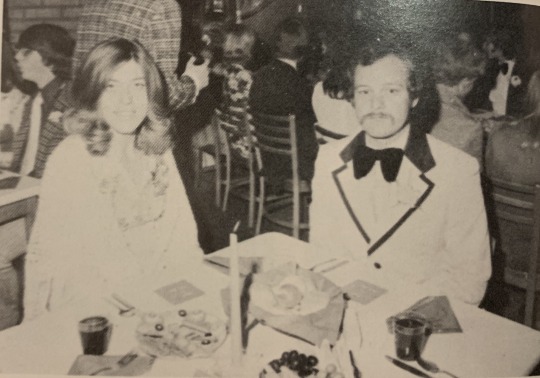
We walked around the back of the cafe/gym.
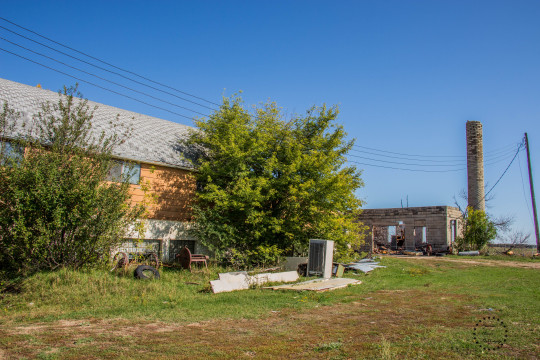
Dad told us the tale of how part of this building exploded. Yes, exploded. In 1973. He didn’t recall from exactly what, but possible natural gas build up he speculated.
They rebuilt it with food delivery in mind - there you can see my husband peering into the window where there was a “slide” for the food boxes to go down.

Looking down the ramp of the food delivery system.
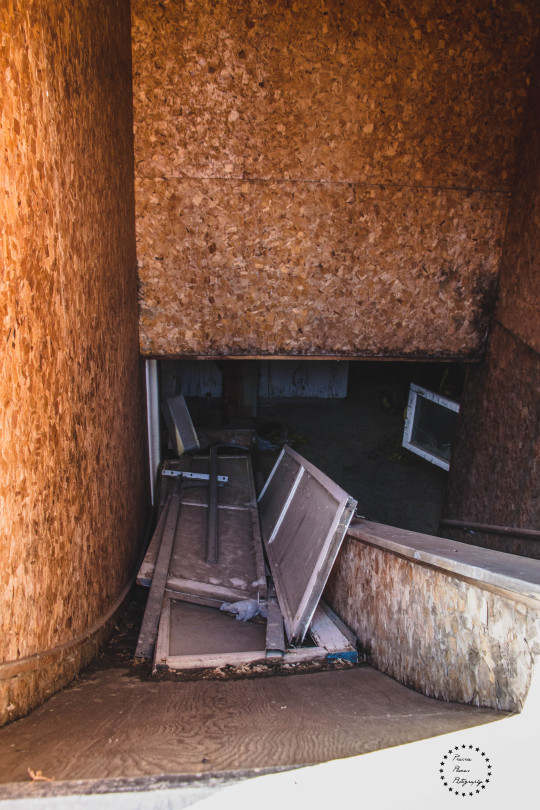
I really wanted to see inside the gym portion of the building. But this is as close as I got.

You can tell it was massive and had a beautiful wooden floor (now buckled from water damage - see the ceiling?) and I sure wish I could have gotten closer.
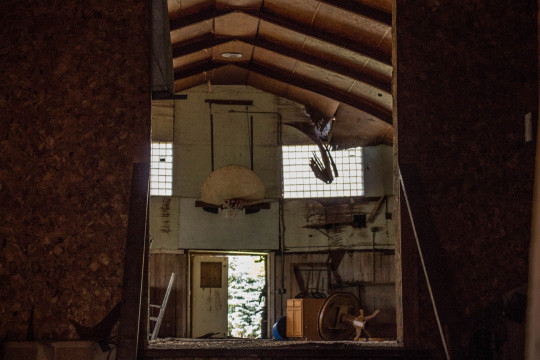
Goodbye cafe and gym!
If any SRA alumni have tales to tell about this building, please comment!

Here is a photo from the 1975 SRA yearbook of the same building.
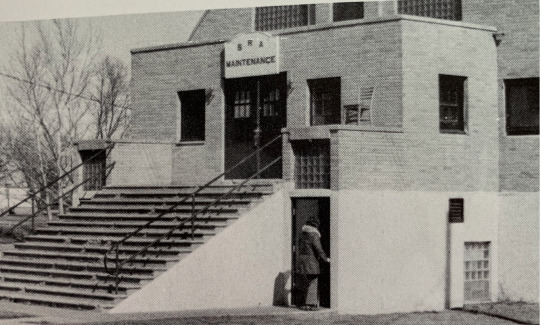
Of course I had to ask dad about this odd building with a big chimney. And he was very familiar with it because this building was related to one of his jobs he had while he attended school here!
You see, everyone who goes to SRA or DAA had/has a job. As a freshman at DAA I worked in the cafe, and after that for the development office, and senior year I had a job in town.
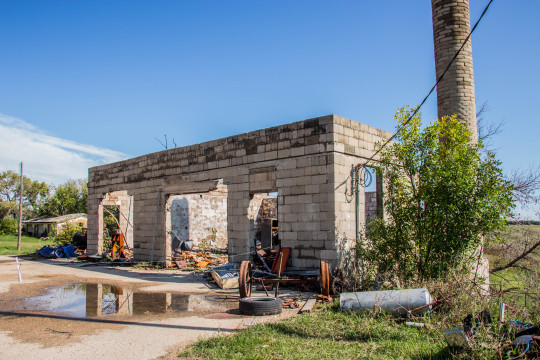
Here is a quick view from the side of this building - SRA has quite a beautiful location!

Anyway, up top here was a garage type setup with a carwash in one area, says dad.
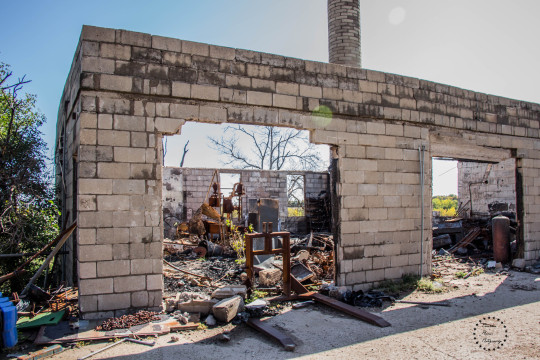
It looked like there was a fire in this building after it was no longer SRA.

Here is the road that goes down to the lower part of the building.
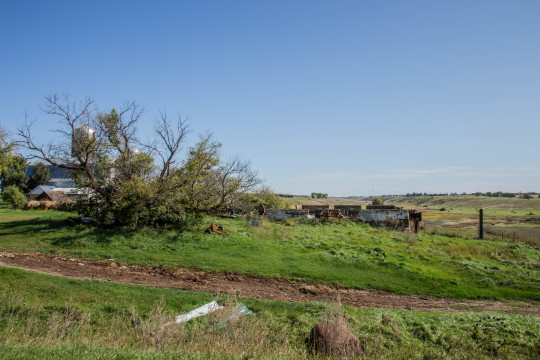
As you can see, it is two stories. Dad’s job was on the lower level.

For his junior year, dad worked hauling coal from Harvey to the coal fired boiler that heated the school. There was a tunnel network that led from this building to each major building on campus, quite the setup) It was hard work, but kind of a coveted job because you only worked one day a week! Sundays.

However, dad said went on to other work his senior year because they changed the pay for the job and it became less desirable.
The boiler house structure was where the "firemen" worked, one guy on duty to make sure the boiler was correctly operating, usually around the clock, particularly in winter.
Flashback time! Here is a photo from the SRA 1976 yearbook featuring Ted (on the right), one of my dad’s lifelong friends, who took over the job after dad left it.

There were desirable jobs when I was at academy too. Some things never change. I didn’t always have a desirable job at academy - I would say working for development was as good as it got. Working in the cafe was a freshman job because it was not cool. But my freshman buddies and I made it fun by singing our hearts out while washing dishes! Anyway, what were the most desirable jobs? Maintenance (you had the run of the school in some aspects), working as a reader for certain teachers was cool, and being an RA was usually desirable. I’m sure there are others, but I just don’t remember them.
We moved away from one back edge of the campus and on to the other.

Here is the back of the Ad building. We’re coming to that soon.

When we reached this garage, dad had another interesting tidbit for us.
This was where some staff kept their cars. Somehow, my dad was allowed to bring his dad’s snowmobile (!) to school one winter, and the dean allowed him to store in his stall!
Ok. This somewhat blew my mind.
First of all. A personal snowmobile. What!?
Second - he got to keep it in a staff garage!? At DAA we certainly wouldn’t have been allowed to mix our things with those of the faculty.
Third - dad had access to this snowmobile, and got to ride it in the winter, and remembers taking it out and getting it up to a high speed on the road outside of campus.
I suppose, approaching this with a 2019 mindset instead of a 1970s one, this just sounds crazy. The liability alone for a student having their own snowmobile is insane to me.
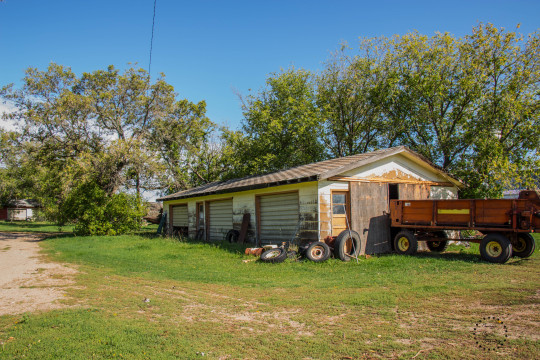
We walked over to the farm area of SRA. Yes, SRA had its own farm!

Note the giant barn and silo. A few students worked there! I think that job was less desirable than dad’s once a week coal hauling job.

Here’s a photo taken in the same area from the 1976 SRA yearbook. You can see the south end of the barn on the left.
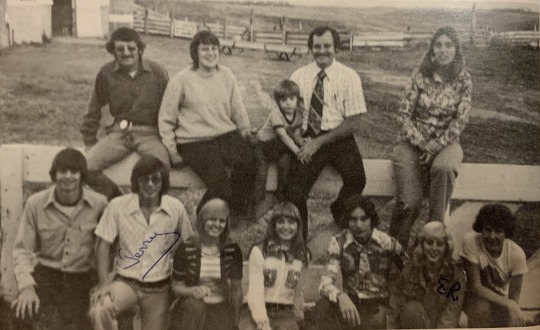
Looking toward the girl’s dorm.
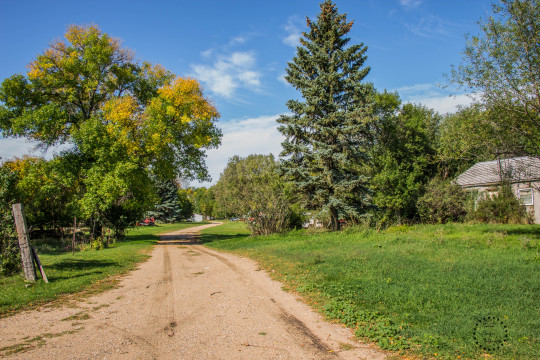
Here is some staff housing, dad didn't remember any specifics about who lived here.
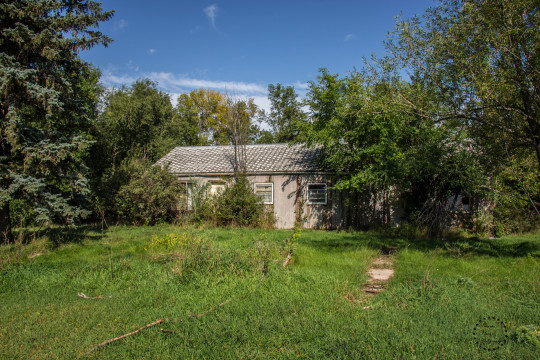
Here is our tour guide himself.

Looking back at the Ad Building from the back corner of campus.

A closer view.
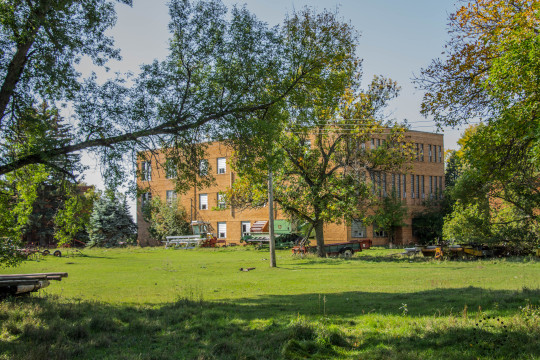
We headed down the road to a building I very much wanted to see - the Girls’ Dorm. It looked shabbier than the boys’ dorm, and was in terrible shape. I so badly wanted to see the rooms where my mom lived during her time here.

As you can see, it’s terribly overgrown.

My mom had various room mates over the years. One of them was my dad’s sister (her future sister in law!) and another was her lifelong friend Karlene. They had such fun stories of their time in the dorm!
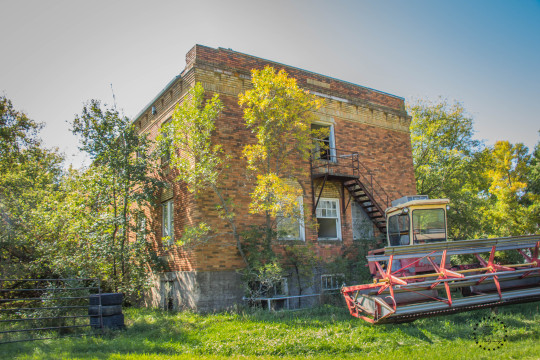
Mom actually was a very quiet, shy, homebody. So living in the dorm was very hard for her. She wanted to go home quite a lot.

I saw something in the distance.
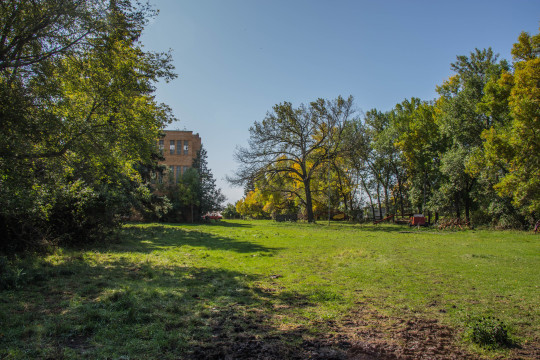
Can you spot it?
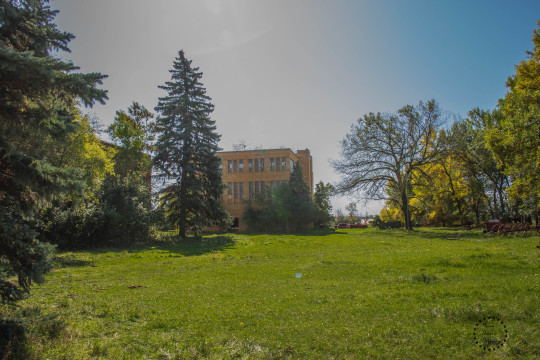
The flag pole, still standing strong. A remnant of when this was a pretty and organized campus.

Dad said it was his friend Lynn’s job to raise, lower and fold the flag each day.

Here is the ad building again. From a distance it looks ok.

We’ll get there soon enough!
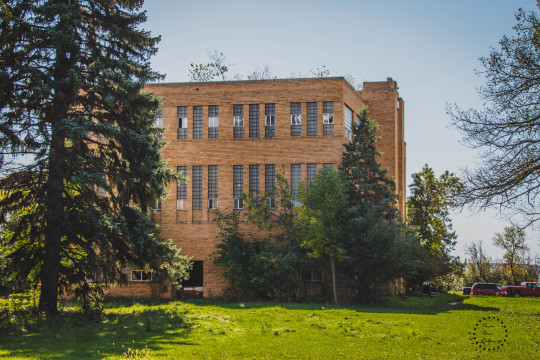
We headed toward the girls’ dorm.
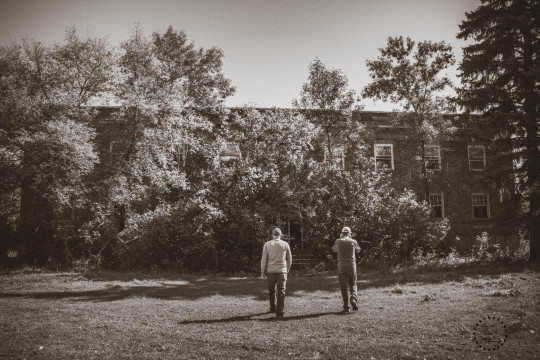
You can hardly see it now, it’s so overgrown. It looks like it doesn’t have the same nice additions as the boys’ dorm. I don’t understand that.

We had to push through a lot of overgrowth to get inside. The doors were just hanging open.

The glass was out of one door anyway. Why bother closing it?

Immediately the smell of decay hit me. It was bad. My husband ran out practically gagging from the mold smell. Dad immediately wrinkled up his nose and left.
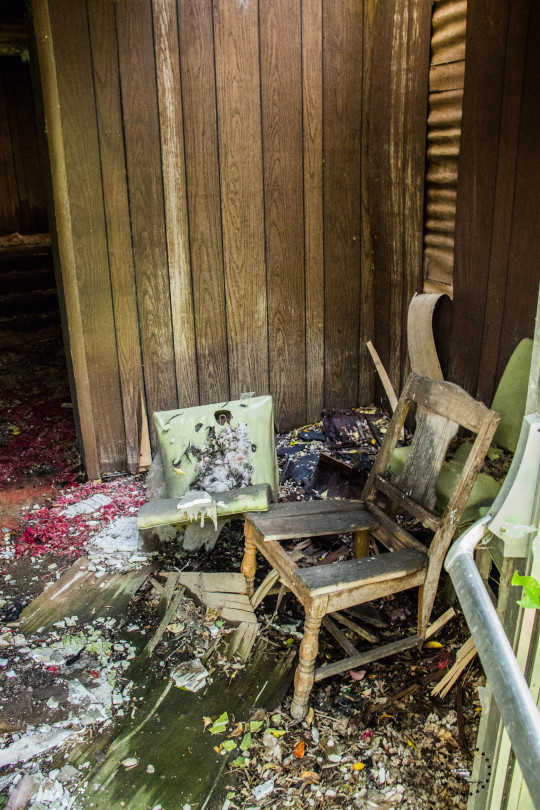
It was clear this place was in terrible shape. I knew it wouldn’t be safe to explore. I was so disappointed. I wanted to see where my mom and many aunts and family friends lived!
A quick side story: during a recent holiday, I was able to speak with two great aunts on my dad’s side of the family. They told me how it felt to go to SRA during WW2. They talked about how that time was permeated with worry. How many of their male classmates were drafted. "You mean, after graduation?" I asked. No, they said. During the school year.
They also recalled how nylon stockings were required to be worn at school for the women. That made me cringe! One my great aunts then informed me that her job on campus was to mend the nylon stockings with a tiny hooked needle. She said it was very difficult. And often, by the time the stocking was repaired, it cost more to repair than it was worth. But nylon stockings were terribly hard to come by during the war.
It was wonderful to talk with these two great women who have seen so much change in their lives. And to hear them reflect on what an absolutely beautiful campus SRA used to be. They made it clear they were not pleased about the campus being closed, and a new one being constructed. "We thought the conference had all this money, back then." They said. They indicated they had to be sold on the idea, and trusted people they shouldn’t have. It sounded like a very controversial time.

How many girls came sweeping out of this entryway in their church clothes, all dolled up in their 1970s best? How many boys stood outside these doors wishing to be on the other side?

The mold and decay smells overpowered me and I had to leave. I knew mom would be heartsick if she saw what happened to a place she lived for three years. A place where she met lifelong friends and met my dad. I felt awful seeing the state of it all.
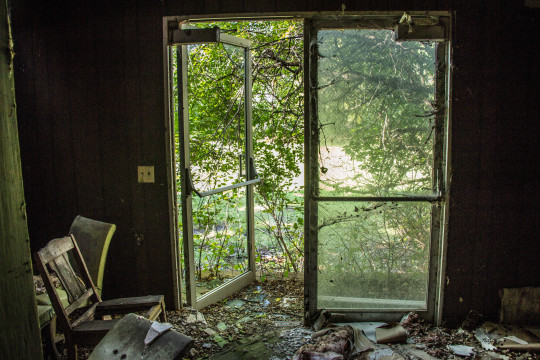
I caught up to my dad who was explaining to my husband about how the campus was heated. He pointed to the sidewalks and said that underneath them were the tunnels that piped coal-powered boiler heat to the entire campus.

My husband headed closer to the Ad building.

There was a hole just cut out of where doors used to be. I looked inside.

I was sick at heart to a) see the state of it and b) see HORSES living in this! They looked so lonely. I was afraid the ceiling was going to collapse in on them.

And here is what remains of this side of the Ad Building.
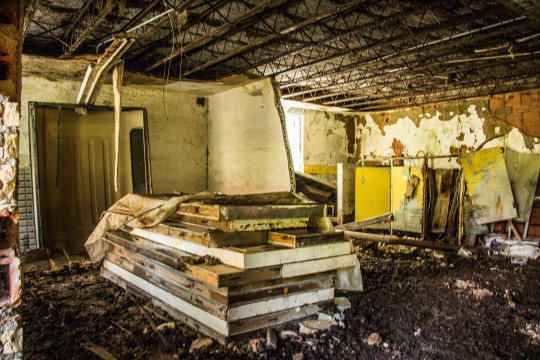
We followed dad to the front of the Ad building. There were still some paths left around campus.
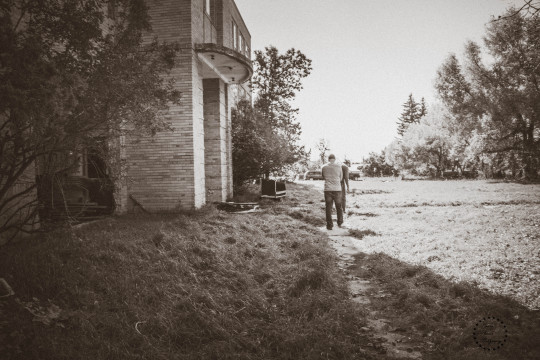
I love the front of the Ad Building. I think it’s imposing. There used to be a sign over this entrance that indicated it was built in 1948.

Another hole cut right in the side of a beautiful building to store an old grain truck. What a shame.
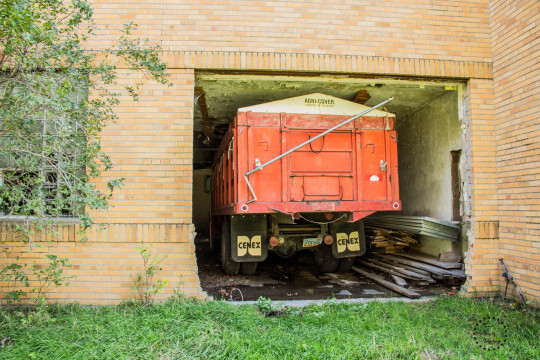
You can see how many windows are knocked out.

Here is the entrance to the Ad Building.
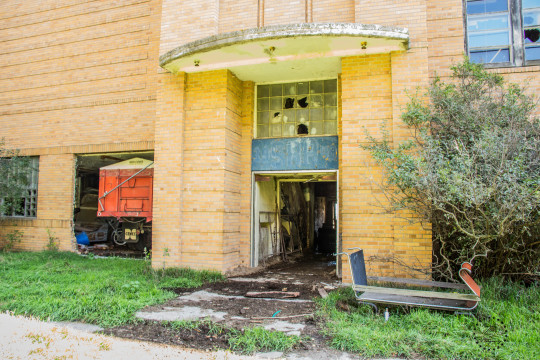
And don’t you love this architecture? I think it’s so art deco and cool.

Dad says that this is where the boys would say goodnight to their girlfriends under the watchful eye of a faculty member. Then the girls would head to the left and and boys to the right to their dorms.
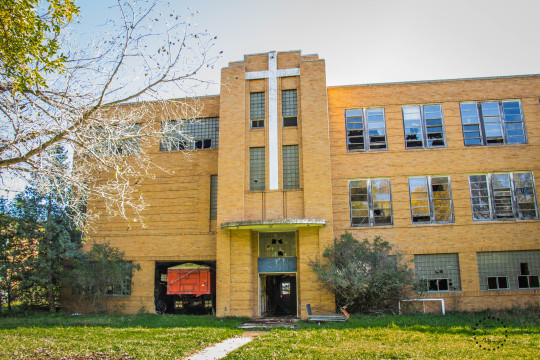
Here is a photo of the same building via the 1975 school yearbook.

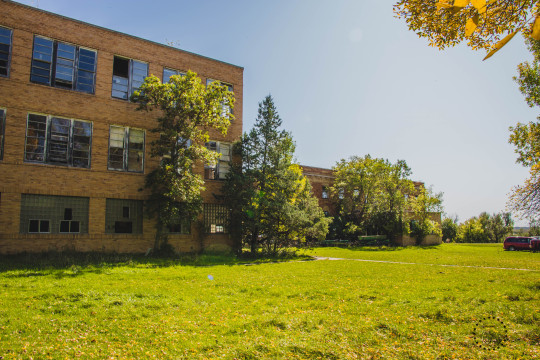
Below: a photo from the 1976 SRA yearbook taken kind of in the area above between the Ad Building and the Boys’ Dorm. That’s my mom, second from left!
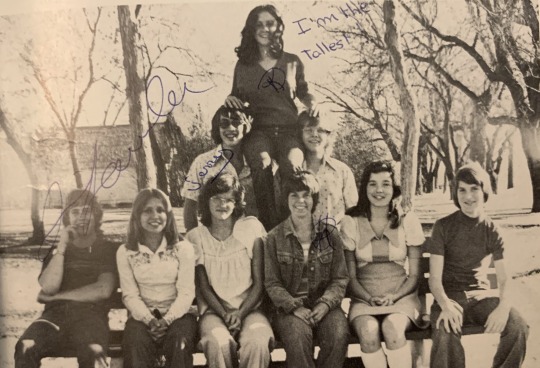
I made my way away from the front of the Ad Building. I never even went here and it was getting depressing. However, my dad didn't seem to feel that way which was good.

I love finding little details like this buried in the brush. Little brick columns, just adding to the pretty campus. From what I’ve seen on old video, this campus was so nice.

Here is a yearbook photo taken in 1975 near the same spot. One of my mom’s good friends, Karlene, second from right. She’s still my friend today!
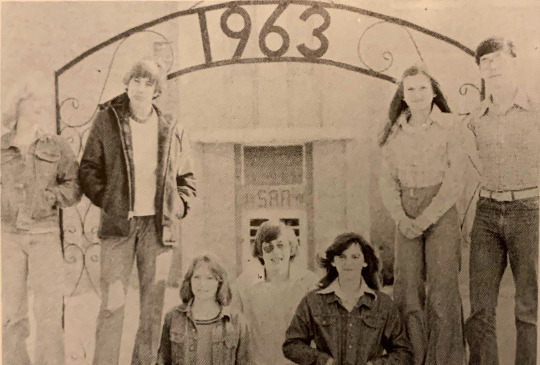
Here’s a view of the columns (you can hardly see them) as seen from the front of the Ad Building.

We headed back to this Auditorium building which is near the Ad Building.

Dad said they’d go here for rec time after supper. He’d walk with mom to the front of the Ad Building and they would say goodnight.

We went around the side.

Dad said there used to be a weight room back here he would use. He of course made a comment about how he recognized the full potential of how "ripped” he could be. Those who know my dad know his sense of humor.
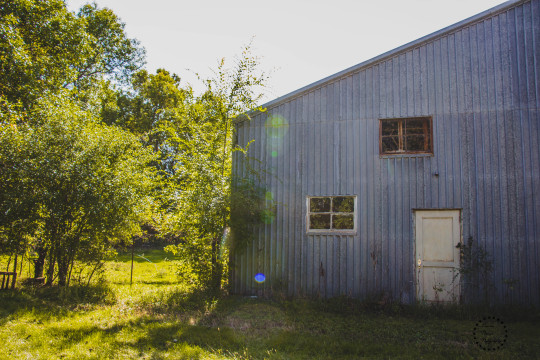
Flashback! Here are some photos of the gym from the 1976 SRA yearbook:
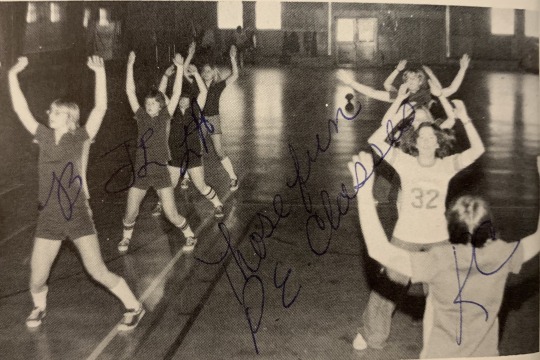

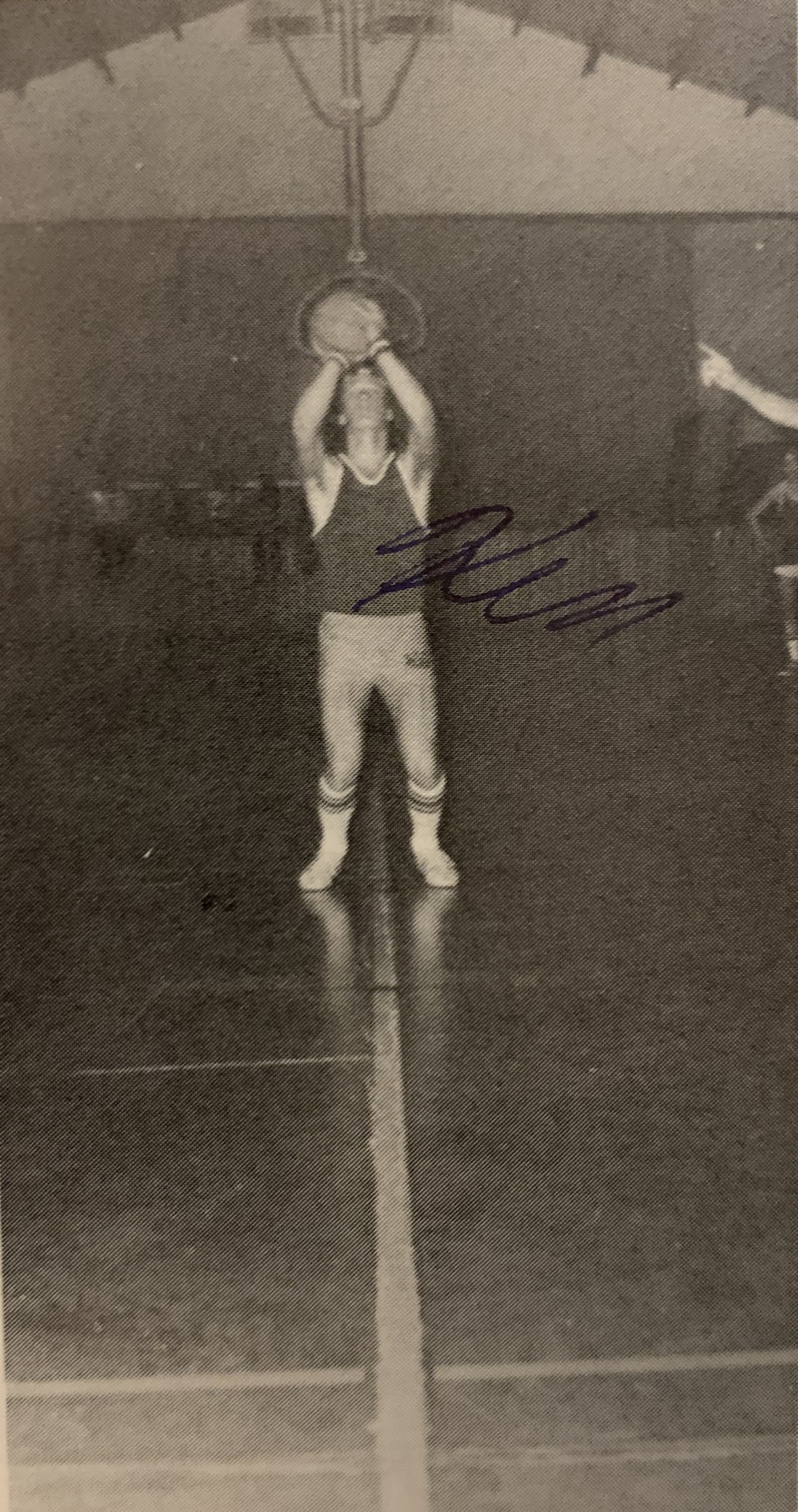
Backing away from the auditorium building. The building on the left were the bathrooms that campers and cabin dwellers used to use during camp meeting (we’ll get to that!) And on occasion students would meet there for boy/girl shenanigans. Scandalous.

In part two we will continue to explore this part of campus - the camp meeting cabins, and circle back around for a tour of the boy’s dorm and more! Stay tuned for part two!
--
*Please be kind to me and others! No need for nasty comments.*
--
Thank you for taking the tour with us! It takes time to photograph these places and edit the photos, and I happily share for all to enjoy. If you’ve enjoyed or appreciated this trip back in time to SRA, please consider supporting me with a donation of a couple bucks! You can donate here, or if you’re interested in prints you can find them here! If you can’t find the print you’re looking for, please let me know and I’ll be happy to help.
#North Dakota#Sheyenne River Academy#abandoned#abandoned academy#abandoned school#boarding school#abandoned boarding school#Harvey North Dakota
2 notes
·
View notes
Text
Lesson 13

I’ve learned the importance of creating memories. Unfortunately, when we are younger we take for granted a number of the things that bring us joy. Not that short-lived joy; that intense, in the moment but fleeting feelings of joy, fading quickly in time and memory. But those moments that you can look back on years, even decades later and the sheer thought of it, brings a flood of other images and a smile across your face, bigger than the Cheshire Cat. I’ve found that these memories are deep rooted in our minds and often attached to a combination of our senses.
I once read how purchasing a new fragrance before going on a trip somewhere for the first time, allows you to store memories that can be associated with that particular scent. Since then I have always looked forward to beginning any overseas trip by perusing duty free for the most perfect scent that will become the signature for this new destination and a constant reminder of the adventures had. I only need to glance at the bottles to be taken back to the places I’ve travelled. Or catch a waft of the scent to be transported across oceans to far off places and I’m instantly back in those moments, despite how much time has passed. Scents can conjure up both images in the mind but feelings deep inside too.
The moment that scents could trigger memories for me, goes back to when I was a youngster at my grandparents. I can see the back steps that led from the laundry down to the yard so vividly, with the reddish-brown bricks on the side closest to the ramp and the few steps beside the garden. It was here that I remember my Gran teaching me that rosemary was for remembrance. She crushed a fistful of leaves in her hand and had me smell it. From that moment on, anytime I would see a rosemary bush, I can’t help but grab a few leaves, crush them in my hand and take a sniff, being instantly transported back to those back steps with my Gran. The smell of roses has the same effect, taking me to the most glorious rose gardens that were my Grandad’s pride and joy in his retirement. These roses were so popular that he ended up having to transport them to garden beds away from the street as they would be picked by passers-by, particularly on Valentine’s Day.
The taste and smell of mangoes and passionfruit also take me back to my childhood and invokes memories of the tree house, my dad built in the mango tree in the backyard. There was a passionfruit vine that crept its way along the length of the fence and a trellis outside my older brother’s window. Many afternoons were spent in the tree house, with a bounty of passionfruit, picked straight from the vine. These were the yellow skinned variety, a lot sweeter, and my brother and neighbourhood friends would bite a hole into the fruit, spitting the hard skin into the vacant allotment beside our house and suck the passionfruit seeds out before discarding the emptied shell of the fruit over the fence. Our Nan used to make a passionfruit syrup, which she’d bottle up and share with the family. Even after I’d grown up and moved away, whenever I’d visit home there’d be a bottle to take back with me.
I find the cliché of songs being the soundtrack to our lives to be completely accurate. There are moments of my life that I can relate completely to a particular song or album. I only have to hear the opening bars to Carole King’s ‘I Feel The Earth Move’ from her Tapestry album and I’m transported to my childhood home. Mum would play this record when she was cleaning. As soon as you heard that song, if you weren’t out the door quick enough, you’d certainly be given a job to do. Songs from musicals such as The Sound of Music, Mary Poppins and the Wizard of Oz, take me to the loungeroom of my Grandparents, snuggled up on the couch with either of them, a cup of hot cocoa (made on the stove) with everyone singing along. J-Lo’s ‘Waiting For Tonight’ and Kylie Minogue’s ‘On A Night Like This,’ will always remind me of the infamous Y2K New Years Eve and a street party in Rockhampton during my university days. Kylie’s ‘Spinning Around’ transports me to a tiny bar in Tokyo, where I tried to recreate her video clip choreography on the bar. There’s certain songs that will instantly remind me of my high school days, working at the grocery store during university, road trips, adventures in new cities, the list is endless.
Today, more so than ever, we have a pocketful of memories, thousands of photos snapped on our phones, but there’s nothing like flicking through a photo album or a slideshow, reminiscing about times from long ago with the loved ones you shared moments with or listening to their stories of adventures had. In a day and age where we ‘capture’ every moment on our phones, it’s just as meaningful taking a picture memory, capturing a moment with all our senses. Brene Brown explains the idea of a picture memory so well in her book, Daring Greatly. She describes a day spent with her daughter Ellen and remembers a moment where she catches her, sitting silently, eyes closed, a quiet smile on her face. When Brene asks Ellen if she’s ok, she responds by saying she’s fine and that she’s taking a picture memory, which she explains is “a picture I take in my mind when I’m really, really happy. I close my eyes and take a picture, so when I’m feeling sad or scared or lonely, I can look at my picture memories.”
@taylorswift sings on ‘New Year’s Day,’ “Hold on to the memories, they will hold on to you,” and I couldn’t agree more. Our memories are what keep us going during the bad times, bring us together during the good times. In the end, it’s better to invest in experiences, not things; so that you have stories to tell, not things to show. So I’ve learned to treasure moments, big and small, practicing gratitude each night before I go to bed, in an effort to imprint those memories in my mind for evermore.
0 notes
Text
The Origins of Overprotective Parenting
Back when I was six years old, the neighborhood I lived in provided the perfect backdrop for an active and idyllic childhood. Half a dozen other boys about my age lived on the same street I did and we quickly banded together to form a little neighborhood gang. We spent the daylight hours building ramps for our bikes, playing pick-up football games in my front yard, and simply scouting around the area. The subdivision I grew up in was still under construction at the time, so there were plenty of partially built houses to explore. After the construction workers left for the day, we’d cruise down the street on our bikes to check out their work and poke around the skeletal structures rising from the muddy lots. The ones that were the most fun to explore were the two-story houses. You’d have to climb up the railing-less, unfinished stairs and when you got to the top, you were able to walk to the edge of the second story’s framing and throw stuff down on your buds. On the lots that didn’t have any houses, we’d engage in intense dirt clod fights. We’d dig foxholes and just start chucking clods of dirt at each other for hours. One of them that came my way had a rock in it and hit me directly in the right eye. I was in the hospital for a few days and had to have surgery to save it. My only consolation was that I got to wear an eye patch for a few weeks just like “One-Eyed Willy” from The Goonies. (The eye is fine these days. Just have a really bad astigmatism in it.) Behind our house was a giant field through which ran a little creek. My friends and I spent hours exploring the banks and gave names to the landmarks we encountered. I remember one day we got particularly brave and started to wade/swim the creek to see where it would take us. From that journey, we found a cool, secluded little alcove, and thought it would be the perfect spot for a fort. So we built one from pallets and old tires we found nearby, and thereafter spent many an afternoon in our secluded hideout. On all these escapades, my parents knew I was out in the neighborhood, but didn’t know exactly where, and didn’t care. The only rule was that I had to be home for dinner. Now, fast forward thirty years. On an evening awhile back, my own six-year-old son headed out to the front yard to play, which was fine with me. But when I went out ten minutes later to tell him something, he was nowhere to be found. I checked the backyard, and the sides of the house. Then I went back inside to see if he was there. I searched through every room, calling his name. A little anxiety crept into my stomach. Now Kate was concerned too and joined in the search. We checked outside again, then inside, then outside, calling his name in ever louder shouts. I got in the car and drove up and down the street and around the block. No Gus. He had seemingly completely disappeared. I drove around the block again, while Kate searched the house and yards for the umpteenth time. Still no sign of him. Anxiety was quickly transforming into full-on panic. The thoughts running through my head were involuntary and terrifying: Someone had taken Gus. I called the police and told them I couldn’t find my kid; they said they’d send an officer over. A couple neighbors started to help us look for him. I got back in the car and widened the circle of my search. Finally, I spotted Gus. He was a few steps from his grandparents’ house, who live a half mile away. With enormous relief, I put him in the car and drove back home. The police arrived soon after. With some sheepishness, I told them that everything was okay, I had found my son. I was left to wonder: Had I been too panicked? In my defense, Gus had never tried, or even expressed interest in walking down the street by himself, much less walking to his grandparents alone. It was totally unprecedented and out of the blue. But that just brings up other difficult questions. Why hadn’t he been interested in exploring on his own? Why wasn’t it normal for him to go off, not only to his grandparents, but to play with other kids in the neighborhood, the way I used to? Yet that’s in fact a hypothetical question, as in reality, there aren’t other neighborhood kids out and about to play with; they’ve all seemingly been sequestered inside. And that fact brings up the most burning questions of all: What’s changed in our culture since I was growing up to create this transformation? What’s behind today’s more cautious parenting style? The Shrinking Perimeter of Children’s Activities and Free Range The norms of responsible parenting have certainly changed a lot in just a single generation. Kids used to walk or bike to school; now they’re not even allowed to walk to and from the bus stop. Children who used to spontaneously gather together in the neighborhood are now set up on supervised playdates. Whereas parents used to kick kids outside, expecting them to roam and not return ’til sundown, they now prefer to keep their children indoors, or at least no farther away than the backyard. If parents do let their kids out of the house, they’re close behind. Thus on a typical playground, you see mom and/or dad hovering next to their child — parents with arms outstretched to catch him or her should they fall off the monkey bars; parents riding down a slide with their child securely positioned on their lap. It’s not just the physical range that children are allowed to autonomously explore which has shrunk, but the range of their allowed activities as well. While young boys a half century ago frequently carried pocket knives wherever they went, the age at which parents feel comfortable giving their children sharp, pointy objects has precipitously increased. Same with lighters and matches. Letting your kid drive the car down the driveway while sitting on your lap? Forget about it. Such observations on the increasingly cosseted nature of childhood aren’t merely anecdotal. Research bears out the fact that modern kids have a far more circumscribed life than their parents and grandparents did. Several studies in the United States, Europe, and Australia have found that over the last 50 years the radius of children’s “independent mobility” has shrunk by as much as 90%; whereas the distance grandpa was allowed to roam from home was measured in miles, for the modern child, it’s measured in yards. According to one study in the U.K., while 80% of third-graders were allowed to walk to school in 1971, that number had dropped to just 9% in 1990, and is even lower today. The prevalence of zero tolerance policies in schools is well-documented and has resulted in cases where an honor roll student gets suspended for bringing a butter knife from home to cut up her peach (she wanted to share it with her classmates). Some schools have even banned running and balls at recess (too likely to cause injuries), and designated games of tag and cartwheels as activities requiring adult supervision. Beyond the anecdotes, studies, and news stories, the change in the culture of childhood and parenting is something most adults these days can simply instinctually feel. What may be harder to grasp, however, is just why this shift has happened. What’s Behind Today’s More Protective Parenting Style You’ve probably heard the types of stats and examples mentioned above. I know they were on my radar years ago, even before I had children myself. Remember that whole “free range kids” thing that bubbled up back in 2008, kicked off by a controversial column in which Lenore Skenazy said she let her 9-year-old son ride the subway alone? I remember. It was two years before I had Gus. And like all childless folks, I had the whole parenting thing figured out. What was wrong with all of Skenazy’s critics? Kids shouldn’t be coddled! I knew exactly the kind of father I was going to be — one who let his children roam and be independent and do risky things. Free range parenting, here I come! Like lots of certitudes I held about childrearing before I actually had kids, this one underwent a lot of adjustment once my real flesh and blood progeny arrived. It’s not that I totally lost my pre-fatherhood ideal — I’ve intentionally sought to have my kids do “dangerous” things like hold knives, play with matches, swing a hammer, and set off fireworks. I encourage them to play by themselves in the yard (though as you’ll see below, I haven’t always been successful in this). I take them camping and hiking and fishing. It’s just that on some stuff, like letting them roam outside alone, I’ve found a greater fear clenching my heart than I had imagined, and even on the stuff I allow them do, letting go and fighting the urge to try to prevent every bumped knee or cut finger has been a lot harder than I thought it would be. While the trend of overprotective parenting has certainly gotten a lot of coverage, much less discussed is exactly why this phenomenon arose in the first place. Why are modern parents so protective of their children (and children in turn so risk averse themselves)? Below are some hypotheses born from research and personal reflection: Families Have Fewer Kids Parents are, on average, having fewer children than they used to and this has arguably not only had a direct impact on their tolerance for their kids’ risk-taking, but indirectly influenced almost all the other factors on this list as well. First, the fewer children parents have, the more time they have to dote on each one of them. Thus, beginning in the 19th century when the fertility rate in the West began a generally downwards trajectory, children started to be seen less as assets for household labor, and more as creatures to simply cherish and adore. They became, in the phrase of sociologist Viviana Zelizer, “economically worthless and emotionally priceless.” Common sense would dictate that this “priceless” valuation would only go up the fewer children a family has; running, as they do, the risk of a tragedy leaving them childless, parents of only one or two kids have more to lose should something happen to them. Winston Churchill was not being facetious when he advised a friend: “You must have four children. One for Mother, one for Father, one for Accidents, and one for Increase.” Of course, parents who have many children don’t feel as if they love each of their children any less, nor would they find the loss of one of them any less devastating than the parents of few children would. Yet, on a subconscious level, it is likely that parents who have many children are a little more comfortable with their kids taking risks, while those with one or two clutch them more tightly. As a father of only two myself, I know I can admit to thinking that if something happened to one of them, I’d only be left with one. I can’t imagine this doesn’t latently increase the (over) protectiveness of my parenting. There’s also the simple fact that more children means less eyeballs to go around. With two kids, each parent can have both eyes firmly on one child. With three or four or even more, parents simply can’t have eyes on all of them at all times; even if they wanted to be over-protective, they’re simply not physically able. Both Parents Working Full-Time+Higher Parenting Expectations More children are raised in households where both parents work full-time than ever before. Yet, paradoxically enough, both mothers and fathers are spending more time with their children, not less — even more than in the 1960s. This may be because today’s parents, many of whom came of age in the 70s and 80s when the divorce rate was highest (contrary to popular belief, it’s been going down ever since), want to create the kind of close-knit family they didn’t enjoy growing up. At the same time, since both mom and dad are working, they feel guilty about not spending enough time with their kids. Compounding this is a culture that has emphasized the importance of loving nurture and active interaction in maximizing a child’s emotional and educational development; with fewer children per family, parents become more invested in the success of each of their kids, and have the mental bandwidth to micromanage its upwards trajectory. So while a 1950s mom often left her kids to play on their own, her modern counterpart is supposed to really get down on the floor and teach and interact with them all the time. The expectation for this more intensive form of parenting hasn’t just fallen on mothers, but fathers as well; whereas dads used to have a more peripheral function in childrearing, they’re now expected (and often desire) a more hands-on role. Today’s dads, in fact, spend 4X more time with their children than fathers did in 1965. As a result of this combination of working parents and high expectations, when moms and dads come home from their jobs, having not seen their kids all day, they’re often not keen on their children going out to play on their own, since this will curtail the family’s only available window for spending quality time together. Parents feel like they should keep their kids close during all their off-hours, intently interacting with them side-by-side. Even though Kate and I only work during the hours of the school day (and then again at night once the kids have gone to bed), I can attest to this phenomenon. We both felt we should be spending all our time with Gus and Scout in our free time, especially when they were very young. Now, as an unintended consequence, even though I think they’ve gotten old enough to be playing on their own, they’re still attached at our hips and want to hang out with us all.the.time. I never would have even thought to “play” with either my mom or my dad when I was growing up, and I’ve taken to trying to explain this fact to Gus and Scout. But to little avail. I can hardly blame them for their uber-attachment — we created the issue ourselves. Children Have Busier Schedules/More Structured Activities Along with the desire to maximize children’s full potential, has also come a rise in structured extracurricular activities. More after-school music lessons, more sports. And it’s never too early to start. Three-year-olds take gymnastic lessons, play soccer (a chaotic herding of cats that goes under the name “soccer”), and do yoga alongside their moms. To leave your kid to his or her own devices is to let their capabilities atrophy — a decision nigh near neglect. The result of this increasingly crowded schedule, Atlantic Monthly writer Hannah Rosin observes, is that if kids aren’t spending time with their parents at home, they’re under the eye of other adults in classrooms and on playing fields: “My mother didn’t work all that much when I was younger, but she didn’t spend vast amounts of time with me, either. She didn’t arrange my playdates or drive me to swimming lessons or introduce me to cool music she liked. On weekdays after school she just expected me to show up for dinner; on weekends I barely saw her at all. I, on the other hand, might easily spend every waking Saturday hour with one if not all three of my children, taking one to a soccer game, the second to a theater program, the third to a friend’s house, or just hanging out with them at home. When my daughter was about 10, my husband suddenly realized that in her whole life, she had probably not spent more than 10 minutes unsupervised by an adult. Not 10 minutes in 10 years.” When children participate in structured activities, they often not only have their teachers’ or coaches’ eyes on them, but their parents are still there too. Whereas parents were more apt to simply drop their kids off for practices (and birthday parties) decades ago, now they frequently stay as a spectator, feeling they should be there to observe their child’s progress, and just in case he or she needs them. With all this supervision, Rosin writes, today’s children “take it for granted that they are always being watched.” While most kids may not be as well-tended as Rosin’s, between the 1980s and early 00s, the amount of time children had at their disposal declined by 9 hours a week on average. Kids empirically don’t have as much time for free, unstructured play as they used to — the kind of unsupervised play in which they’re most apt to take risks and explore their limits. Kids Have Fewer Neighborhood Playmates I’ve noticed that the older Scout gets, and the more she can play with Gus, the more he (and she) have finally been detaching from Kate and I and playing on their own. From this I’ve concluded that while Gus’ reluctance to play by himself likely had something to do with my coddling, it was also simply due to not having a playmate. In a neighborhood where there aren’t any kids his age, he had to wait for Scout to mature to the point that she could function as such. Think about the times you not only did the most exploring as a child but also engaged in the riskiest activities. It was probably when you were in a pack of other kids. While independent, boundary-pushing play is something children engage in by themselves, it really comes into fruition in the context of neighborhood “gangs.” Out from under the watch of adults, kids egg each other on into taking more risks — risks they wouldn’t have otherwise tried their hand at. With fewer siblings and fewer neighborhood kids to go around these days, this formerly central part of the childhood experience is seemingly going extinct. Technology Of course, no discussion of overprotective parenting could overlook the role of technology in this phenomenon. Even if the parents of yesteryear had wanted to keep their children indoors, there just wasn’t enough to do around the house to keep them entertained. Parents didn’t want to be around bored kids, any more than kids wanted to be bored, leaving the latter to be shooed outside — if they hadn’t already headed out of their own free will and choice. Today, with a virtual world to explore at every child’s fingertips, keeping children inside is a viable option for parents, and a welcome one for youth. Kids are entertained by their devices; parents rest easy knowing their children are safe at home. At the same time, technology has also increased our expectations for connectedness. There was a time, so recent in history it is part of my personal memory, that people of any age could only be contacted by landline; there were wide swaths of the day where they were completely unreachable, and you accepted that. In the age of GPS and smartphones, our expectations have vastly changed and heightened. We expect to be able to touch base with anyone at any time. This expectation has undoubtedly carried over into how we raise our children. Not being able to contact your kids for hours was normal for my parents’ generation; for my own, it can seem strange, and scary. Fear of Litigation In 1978, parents of a boy who became paralyzed and brain damaged after falling from the top of a playground slide sued the Chicago Park District, eventually settling for $9.5 million dollars seven years later. Thereafter, the U.S. Consumer Product Safety Commission issued a “Handbook for Public Playground Safety” that offered suggestions for making equipment safer. While only meant to serve as guidelines, park managers around the country, fearing similar ligation, spent the next several decades zealously transforming playgrounds into tamer, safer — many would say more sterile — romping grounds. Just recently the playground closest to our house ripped out its configuration of multiple monkey bars and metal slides, installing in its place some plastic, prefab doohickeys mounted atop a platform of rubber matting. What’s funny is that half of the new, ground-level apparatuses are designed to spin, the designers seemingly believing that the nausea induced by dizziness could substitute for the flutter of fear provoked by height — by actual risk. Funny too, that the kids still try to use the equipment in “dangerous” ways for which it was not intended — climbing on top of it, rather than following its predetermined functions. You can change the equipment, but you can’t totally change the heart of a child. Litigation-inspired policies and spiking insurance premiums for schools and clubs are certainly working to flatten the landscape of that heart, though. Zero tolerance rules for weapons, bans on soccer and football at recess, Scout manuals filled with more safety disclaimers than requirements have taken much of the surprise, risk, and fun out of childhood. Fear of Busybodies It’s not just lawsuits that people have to fear these days, but the nosiness of their neighbors as well. Even if you want to let you children be a little “free range,” it’s became such an anomalous choice, that it is likely to be met with the disapproval of one’s peers (and even one’s own parents and in-laws, who, though they raised you that way, no longer feel it’s an appropriate approach to childrearing). More worrisome still, is the possibility that these onlookers could call the authorities on you. Within a single generation, behaviors that were once commonplace have become illegal acts of child endangerment There have been well-publicized cases where concerned citizens have actually called the police to report the fact that children were walking alone in the neighborhood; their parents consequently had to endure accusations of neglect and an investigation by Child Protective Services. Other parents have been charged with felony neglect for letting their 11-year-old son play in the backyard alone for an hour and a half. Parents have even been charged with “contributing to the delinquency of a minor” after leaving their child unattended in a locked car while running inside a store for a few minutes. Even if one’s hands-off approach doesn’t become criminally dangerous, it can be socially so. If you’re the parent who’s sitting back while other mothers and fathers hover around their kids, you run the risk of being considered an unfit caretaker. While a scowl of reproach should be easy enough to brush off, the pressure to follow new childrearing norms is pervasive, and subtly influences behavior. Even those who find the new norms silly, feel pushed to fall in line. Fear of Crime, or, More Accurately, the Illusion of Control One of the most obvious causes of overprotective parenting is the idea that while it was okay for kids to be by themselves thirty or forty years ago, the world is just a more dangerous place now. We’ll delve into specific stats as to whether crimes like abduction have really gone up or down when we continue our discussion of this topic next week. I’m sure, though, that I don’t need to even insert a spoiler alert before saying that the world is in fact not a more dangerous place than it was when I was a boy. Why does it feel like it then? Many would point the finger at the rise of 24/7 news networks and websites, and their relentless, sensational coverage of kidnappings, rape, murder, etc. As this thinking goes, even though crime has actually gone down in most places, we feel like it’s gone up because images of violence and tragedy fill our screens and are constantly in our faces; more bad things aren’t happening, it just seems like they are because they’re covered to an extent disproportional to their occurrence. While this argument is often forwarded, not only in regards to crimes against children, but to explain why people feel the world is getting worse in general, I’ve never personally found it all that convincing, as the idea that we’re consuming way more news than we used to just isn’t historically accurate. While folks didn’t have the internet a century and a half ago, newspapers did come out in multiple editions a day; you could grab a paper morning, noon, and night, and sometimes in-between when something really big happened. And the stories the papers carried in this age of “yellow journalism” were just as sensationalistic, if not more so, than they are today; if you don’t believe me, check out the offerings of the nineteenth’s century’s National Police Gazette. So while the citizens of yesteryear were not wholly as plugged-in as we are, their appetite for news was just as large, and fed quite regularly. Perhaps it’s the more graphic nature of modern news then? Old-time newspapers had black and white illustrations and later photographs; now we’ve got far more photos, plus endless video coverage, all in living color. Maybe seeing the innocent faces of abducted kids, and watching film roll of his distraught parents, brings the story home in a vivid way, and creates a much more visceral sense of fear in parents’ hearts? Likely so. And yet this explanation cannot explain the whole story either. In 1800, 43% of the world’s children died before ever reaching their fifth birthday. In 1961, the child mortality rate was still 18.5%. Today it’s 4.3% for the world as a whole, and a tiny fraction of that in the United States. In 1935 in the U.S., there were 450 deaths per every 100,000 children under the age of four; today there are fewer than 30 deaths per the same cohort. Many, many parents centuries and even decades ago, did not just see stories of children dying through their screens, they experienced it firsthand. In their neighbors’ families, in their own families. Visiting a cemetery from the 19th century and seeing how many gravestones are emblazoned with a heartrendingly short span between the years of birth and death, viscerally brings home how very common losing a child used to be. Many of these deaths were caused by disease, of course, but to read the historical record is to find that plenty of children died in accidental and unexpected ways too: mishandling of tools/weapons, falling into fire, being eaten by an animal. Parents of yesteryear thus experienced the injury and death of children in a way that was even more up close and personal than we do, and yet they were less protective of their kids, not more. What then accounts for this paradox? We’re surely back again to the number of children each family had; parents of a past century might have a dozen, knowing at least several wouldn’t live to see adulthood. But there’s also a difference in worldview at work. A divergence in philosophies. One explanation that’s been offered for the rise of overprotective parenting is that the world feels so uncertain today, and the rearing and safety of our children seems like one of the few things we can control. But it’s hard to imagine that folks living in a time where nearly half of their children would die before age five didn’t also feel like life was cruelly uncertain. The world has in fact always been uncertain; it’s just that the way we’ve responded to this uncertainty has changed. In the past, in a time where there was less scientific knowledge and less technology, people saw life as more influenced by fate and divine will. As they could not control these forces, they resigned themselves to doing the best they could in life, accepting that the rest of the chips would fall where they would. Some suffering was inevitable. As knowledge and technology has expanded in the modern era, so have our expectations for control. In a secular society, we see the power to shape events as resting almost entirely in our own hands. We’ve been bequeathed tools that can help our children and ourselves live longer, easier, safer lives, and this has colored our whole perspective. If science and technology can save millions of lives, could it not conceivably save them all? All tragedy, even death from old age, has come to be seen as ultimately preventable. This outlook, this myth of progress, can’t help but permeate out parenting. Why should any child have to get hurt? Why should any child die? Our faith in the possibility of complete control is profound; if we try hard enough, we can outsmart all tragedy. Of course, this faith is only an illusion. The whims of Fate still operate as they always have. The die of chance keeps rolling. Our efforts to carefully check and contain, regulate and arrange, can assuredly mitigate some dangers, but can never quash them all. Randomness ensures the inevitability of risk. Yet our efforts to slay the indestructible understandably continue, increasing as the goal seemingly gets closer and closer, yet remaining forever out of reach. Conclusion After I brought Gus back home from his ambulatory adventure, I made a concerted effort not to act at all mad at him. I didn’t want him to think that what he had done was inherently wrong. I told him in fact that I was glad and proud that he had wanted to head off by himself, and that I had just been worried because he hadn’t told me where he was going. Despite how terrible the experience of feeling like he’d been snatched from the front yard had been, the next evening I allowed him to go back out there to play by himself. But am I ready for him to walk to his grandparents’ house alone? I think he might need to be a little older for that. I’m still trying to figure out where exactly to draw the lines. Because the new style of protective parenting isn’t wholly without merit. Maybe it’s prevented an astigmatism or two. And children are spending even more time with parents, especially dads, and forging an even closer bond with them. I’m not a parent who thinks you should relinquish the role of authority in order to be equal buddies with your kids, but I like that my little guy and I do so much together. And it seems good for him and Scout too; for all the time children these days spend with adults, they seem more mature, at least in some ways, than children of the past. Yet stats on whether protective parenting prevents injuries and abductions aren’t very strong, and the benefits of protective parenting aren’t an unalloyed good; our close bond comes at a cost. As it turns out, sometimes when you try to smother one kind of danger, another variety simply pops up in its place. In making our kids more safe in some ways, we’ve made them less safe in others. To this very real risk of not letting kids do risky things, and the need to balance both sides of the equation, is where we will turn next time. The post The Origins of Overprotective Parenting appeared first on The Art of Manliness. http://dlvr.it/NnshLX
7 notes
·
View notes
Text
How Zombie Culture Shaped Homesteading Today
We can thank apocalyptic fiction and zombie mania for a giant surge in self-reliance and homesteading today. It’s amazing how people grow when they question, “What if?”
Mainstream society gained interest in apocalyptic fiction after World War II, with the possibility of nuclear disaster. Spurred on by the literature, the survivalist movement increased during the Cold War. Civil defense programs advocated bomb shelters and religious organizations advised families to keep a year’s worth of food storage for emergencies. Survivalists cited the Great Depression as an outstanding example of why households should stay prepared and continue homesteading today.
Zombies did not enter the scene until a couple decades later. The first zombie movie to focus on the dangers of conformity and being unable to rely on people to do the greater good was Night of the Living Dead in the 1960s. It also focused away from the grim realities of economic depression and encroaching communism. The idea of the zombie apocalypse allowed people to imagine how fragile society is, and to deal with their own anxieties about the end of the world, while distancing themselves and reveling in the padding of fantasy.
Ice Storms, Power Outages, Blizzards... Are you ready?
Let our experts help you prepare for the worst. Start your emergency preparation by downloading this FREE Guide. YES! I want this Free Report »
Most zombie-related plotlines follow small groups of survivors that deal with shock and denial as they try to make their way through the ravaged world. They must survive the dangers. Then they must rebuild. Both the survival and the rebuilding have caught public attention as fans imagine how they would survive in an apocalypse.
Side by side, zombie fiction grew with modern times, riding speculation of real-life disasters and fueled by terrorist attacks and talks of irreversible global climate change. Hardcore preppers argued about economic downturn or a Malthusian population crash. Zombie fans discussed what would happen if the dead came back to life.
The zombie genre has become so popular that organizations and companies crafted tongue-in-cheek weapons, protective gear, and literature aimed toward dealing with an apocalyptic setting. But it was still just fantasy.
Then the world shifted within a few years. As talks of climate change ramped up, so did problems closer to home. Food Inc., released in 2008, informed the public that we could no longer trust our food system. Then the Great Recession struck in 2008-2009, causing an economic and housing crisis. The public turned from apocalyptic fiction and paid attention to reality. And what they saw scared them. The same tropes described in their books and TV shows lay before them as irreversible climate change, economic downturn, and proof that mankind would not support the greater good when tempted by personal gain. People grappled with the question, “What if?”
“What if the recession gets worse?”
“What if I can’t find a job after college?”
“What if I can’t trust anyone anymore and have to take care of my family by myself?”
This dilemma especially affected ages 20-40, the same demographic targeted by zombie fiction. Younger adults, whose grandmothers had canned food or whose great-grandfathers had homesteaded the wilderness, acknowledged that skills were dying. Somewhere in the last century, self-reliance had faltered. Children had walked away from their homestead heritage, had turned their backs on the ability to feed and clothe themselves without depending on a corporate infrastructure. These younger adults wanted control back. Control over their lives, their food. They wanted to stop feeling helpless.
But when they voiced their concerns, saying, “When the economy collapses,” they faced laughter from naysayers who called them paranoid and irrational. If they instead used the language, “When the zombies come,” they won amusement from other fans. So they focused on zombies.
In May of 2011, The Centers for Disease Control and Prevention used a fictional zombie-based scenario to teach survival techniques for possible real-life scenarios. The idea came about when directors acknowledged that the public is unlikely to pay much attention to tips on surviving natural disasters. A campaign focusing on zombies reached an audience that normally ignored warnings from the CDC. The directors argued that, if you could survive zombies, you could survive anything. The blog became so popular that the CDC then offered a contest for YouTube videos portraying the best and most creative ways to prepare for an apocalypse. They also released a graphic novel stressing the importance of homesteading your house; laying aside necessities such as food, medical supplies, and clean water in case of an apocalypse…or any other disaster.
In October of the same year, The Weather Channel published an article titled, “How to Weather the Zombie Apocalypse,” which discusses how temperature affects zombies and if they were easier to outrun in the heat or the cold.
When Max Brooks’ novel World War Z became a New York Times bestseller, readers turned to his previous work, The Zombie Survival Guide, a satirical book based on real-life guides published by prepper groups.
As zombie mania took society by hold, so did modern homesteading. Back-to-the-land movements have occurred since Roman times but this one was fueled by the media. New works such as The Backyard Homestead by Carleen Madigan, published in 2009, and Urban Homesteading, by Rachel Kaplan, in 2011, taught readers that through homesteading your house you can take little steps back to having control of your life and environment.
In 2013, AMC’s The Walking Dead became the highest rated show on television. Zombie fever had struck mainstream. The audience was larger than ever. People saw themselves in fictional characters, humans just trying to survive in a world gone wrong. They imagined they could thrive as well as the toughest heroes and heroines.
Zombies’ contribution to the homesteading movement was optimism instead of fear. The fantastical edge allowed enough distance to keep people moving forward. Rather than hunkering down with supplies of food and water, believing the world was doomed, people took steps toward self-reliance. They believed they could survive situations through their own hard work, whether they faced zombies, societal collapse, or natural disasters.
Jean Booth, an author of three zombie novels, writes about a small group of people that find a farm and defend it in the Nevada desert. “When writing Zombie War,” she says, “it really brought to my attention how completely and utterly unprepared I am for an apocalypse on any level. As an American, I feel spoiled—if I want or need anything, I can just drive to my local store and pick it up. I didn’t even know how to properly identify a ripe avocado! As I age, I yearn to learn more about becoming self-sustaining, independent of the world around me. Not just in case of an apocalypse—which could happen—but for my own satisfaction of being able to provide the absolute necessary things for my families’ survival.”
Jean has since identified strengths and weaknesses within her lifestyle. Though unable to farm, she and her husband can offer defense to her survival team. She has already considered whom to invite in the event of an apocalypse.
Other creators of zombie fiction are focusing more on the rebuilding aspect. J. Whitworth Hazzard penned a quartet of stories about Jeremy, a teenager trying to survive within a complex of apartments in Lower Manhattan as a sea of zombies fills the streets below. Within Dead Sea Games, the zombies are less of a threat than lack of food, bad sanitation, and untrustworthy humans. In between helicopter drops from the government, the Colony survives on rooftop gardens they built after the Emergency. But nothing is a sanctuary.
As with all fads, readers and viewers tire of repeating tropes. Zombies will someday go the way of vampires. But the modern homesteading movement is on an upswing. Households and communities still respond to questions of, “What if?”
“What if the food system never gets better?”
“What if another recession hits?”
“What if my husband loses his job and I can’t go back to school?”
And optimism builds. People devour information on homesteading blogs and pass it along. They want to know how to start living off the grid and regain their homestead heritage. Communities form. Children turn toward their grandparents’ talents instead of continuing their parents’ slow journey away from sustainability.
Even after zombies have shuffled out of literature and into history, their contribution remains with a revitalized generation that can, once again, take care of themselves through homesteading today in the event that “What if” actually happens.
*Photos from the family collection of Josie Beaudoin
How Zombie Culture Shaped Homesteading Today was originally posted by All About Chickens
0 notes
Text
How Zombie Culture Shaped Homesteading Today
We can thank apocalyptic fiction and zombie mania for a giant surge in self-reliance and homesteading today. It’s amazing how people grow when they question, “What if?”
Mainstream society gained interest in apocalyptic fiction after World War II, with the possibility of nuclear disaster. Spurred on by the literature, the survivalist movement increased during the Cold War. Civil defense programs advocated bomb shelters and religious organizations advised families to keep a year’s worth of food storage for emergencies. Survivalists cited the Great Depression as an outstanding example of why households should stay prepared and continue homesteading today.
Zombies did not enter the scene until a couple decades later. The first zombie movie to focus on the dangers of conformity and being unable to rely on people to do the greater good was Night of the Living Dead in the 1960s. It also focused away from the grim realities of economic depression and encroaching communism. The idea of the zombie apocalypse allowed people to imagine how fragile society is, and to deal with their own anxieties about the end of the world, while distancing themselves and reveling in the padding of fantasy.
Ice Storms, Power Outages, Blizzards... Are you ready?
Let our experts help you prepare for the worst. Start your emergency preparation by downloading this FREE Guide. YES! I want this Free Report »
Most zombie-related plotlines follow small groups of survivors that deal with shock and denial as they try to make their way through the ravaged world. They must survive the dangers. Then they must rebuild. Both the survival and the rebuilding have caught public attention as fans imagine how they would survive in an apocalypse.
Side by side, zombie fiction grew with modern times, riding speculation of real-life disasters and fueled by terrorist attacks and talks of irreversible global climate change. Hardcore preppers argued about economic downturn or a Malthusian population crash. Zombie fans discussed what would happen if the dead came back to life.
The zombie genre has become so popular that organizations and companies crafted tongue-in-cheek weapons, protective gear, and literature aimed toward dealing with an apocalyptic setting. But it was still just fantasy.
Then the world shifted within a few years. As talks of climate change ramped up, so did problems closer to home. Food Inc., released in 2008, informed the public that we could no longer trust our food system. Then the Great Recession struck in 2008-2009, causing an economic and housing crisis. The public turned from apocalyptic fiction and paid attention to reality. And what they saw scared them. The same tropes described in their books and TV shows lay before them as irreversible climate change, economic downturn, and proof that mankind would not support the greater good when tempted by personal gain. People grappled with the question, “What if?”
“What if the recession gets worse?”
“What if I can’t find a job after college?”
“What if I can’t trust anyone anymore and have to take care of my family by myself?”
This dilemma especially affected ages 20-40, the same demographic targeted by zombie fiction. Younger adults, whose grandmothers had canned food or whose great-grandfathers had homesteaded the wilderness, acknowledged that skills were dying. Somewhere in the last century, self-reliance had faltered. Children had walked away from their homestead heritage, had turned their backs on the ability to feed and clothe themselves without depending on a corporate infrastructure. These younger adults wanted control back. Control over their lives, their food. They wanted to stop feeling helpless.
But when they voiced their concerns, saying, “When the economy collapses,” they faced laughter from naysayers who called them paranoid and irrational. If they instead used the language, “When the zombies come,” they won amusement from other fans. So they focused on zombies.
In May of 2011, The Centers for Disease Control and Prevention used a fictional zombie-based scenario to teach survival techniques for possible real-life scenarios. The idea came about when directors acknowledged that the public is unlikely to pay much attention to tips on surviving natural disasters. A campaign focusing on zombies reached an audience that normally ignored warnings from the CDC. The directors argued that, if you could survive zombies, you could survive anything. The blog became so popular that the CDC then offered a contest for YouTube videos portraying the best and most creative ways to prepare for an apocalypse. They also released a graphic novel stressing the importance of homesteading your house; laying aside necessities such as food, medical supplies, and clean water in case of an apocalypse…or any other disaster.
In October of the same year, The Weather Channel published an article titled, “How to Weather the Zombie Apocalypse,” which discusses how temperature affects zombies and if they were easier to outrun in the heat or the cold.
When Max Brooks’ novel World War Z became a New York Times bestseller, readers turned to his previous work, The Zombie Survival Guide, a satirical book based on real-life guides published by prepper groups.
As zombie mania took society by hold, so did modern homesteading. Back-to-the-land movements have occurred since Roman times but this one was fueled by the media. New works such as The Backyard Homestead by Carleen Madigan, published in 2009, and Urban Homesteading, by Rachel Kaplan, in 2011, taught readers that through homesteading your house you can take little steps back to having control of your life and environment.
In 2013, AMC’s The Walking Dead became the highest rated show on television. Zombie fever had struck mainstream. The audience was larger than ever. People saw themselves in fictional characters, humans just trying to survive in a world gone wrong. They imagined they could thrive as well as the toughest heroes and heroines.
Zombies’ contribution to the homesteading movement was optimism instead of fear. The fantastical edge allowed enough distance to keep people moving forward. Rather than hunkering down with supplies of food and water, believing the world was doomed, people took steps toward self-reliance. They believed they could survive situations through their own hard work, whether they faced zombies, societal collapse, or natural disasters.
Jean Booth, an author of three zombie novels, writes about a small group of people that find a farm and defend it in the Nevada desert. “When writing Zombie War,” she says, “it really brought to my attention how completely and utterly unprepared I am for an apocalypse on any level. As an American, I feel spoiled—if I want or need anything, I can just drive to my local store and pick it up. I didn’t even know how to properly identify a ripe avocado! As I age, I yearn to learn more about becoming self-sustaining, independent of the world around me. Not just in case of an apocalypse—which could happen—but for my own satisfaction of being able to provide the absolute necessary things for my families’ survival.”
Jean has since identified strengths and weaknesses within her lifestyle. Though unable to farm, she and her husband can offer defense to her survival team. She has already considered whom to invite in the event of an apocalypse.
Other creators of zombie fiction are focusing more on the rebuilding aspect. J. Whitworth Hazzard penned a quartet of stories about Jeremy, a teenager trying to survive within a complex of apartments in Lower Manhattan as a sea of zombies fills the streets below. Within Dead Sea Games, the zombies are less of a threat than lack of food, bad sanitation, and untrustworthy humans. In between helicopter drops from the government, the Colony survives on rooftop gardens they built after the Emergency. But nothing is a sanctuary.
As with all fads, readers and viewers tire of repeating tropes. Zombies will someday go the way of vampires. But the modern homesteading movement is on an upswing. Households and communities still respond to questions of, “What if?”
“What if the food system never gets better?”
“What if another recession hits?”
“What if my husband loses his job and I can’t go back to school?”
And optimism builds. People devour information on homesteading blogs and pass it along. They want to know how to start living off the grid and regain their homestead heritage. Communities form. Children turn toward their grandparents’ talents instead of continuing their parents’ slow journey away from sustainability.
Even after zombies have shuffled out of literature and into history, their contribution remains with a revitalized generation that can, once again, take care of themselves through homesteading today in the event that “What if” actually happens.
*Photos from the family collection of Josie Beaudoin
How Zombie Culture Shaped Homesteading Today was originally posted by All About Chickens
0 notes